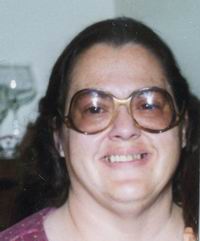A SunTran bus driver showed up at Harriet Moldov-Taylor’s Albuquerque apartment on September 27, 2003, to take her for her dialysis appointment. He entered her apartment out of concern when she didn’t answer the door, for she had already missed two dialysis appointments. He was horrified to find the 56-year-old disabled woman on her floor, unconscious in a pool of blood seeping from her mouth and rectum. It was determined she had lain there bleeding for a few days.
Harriet passed on in the hospital on October 1. Her attending physician believed she had been raped. Her autopsy also determined she had died of a stroke caused by plaque getting disturbed from her carotid artery due to the violence she had endured. The medical examiner found deep tears in both her vagina and rectum, consistent with rape; these tears had not had a chance to start healing, suggesting they were recent. There was also evidence she had been thrown down or hit over the head based on the brain damage she had sustained. Her body had substantial bruising. She had lost over 3 liters of blood, yet very little was in her apartment, suggesting someone had cleaned it up.
Harriet Moldov-Taylor was 320 pounds, nearly blind, and unable to bend her knees. She relied on a wheelchair to get around. She suffered from diabetes and rheumatoid arthritis. Thus, she needed a lot of assistance to take care of herself. She also was unable to clean her apartment. For these reasons, police refused to believe she may have been raped. Apparently they think only sexy able-bodied people are appealing enough to be raped.
Thus, police refused to do much of an investigation at all. They barely looked around in her squalid apartment, then came away with the theory that her injuries must be self-inflicted or from consensual sex. Harriet’s case shows a glaring lack of sensitivity and competence among police, as well as a lack of understanding of disability. She was clearly murdered, yet police have not shown any initiative in finding her killer. When Harriet’s death was determined to be homicide by the OMI, police talked about filing a complaint against the doctor who did her autopsy. They refused to admit that they had to work.

Harriet did not have much family left and none of her family was local. Police insisted on speaking to her cousin, Carole Ulrich-Fromer. They would not deal with her power of attorney, her friend since high school, Tennise Gallegos. Nor would they speak to her half-sister. Unfortunately, Harriet and Carole had not spoken in twenty years, so Carole was not the most sufficient source of information about Harriet’s habits or associates. She was not able to give police the complete picture they needed to move the case forward. Not that police seemed to care.
Initially, Carole told the Albuquerque Tribune that she believed her cousin had been murdered. But Detective Jojola then spoke with her and convinced her that Harriet had engaged in consensual rough sex. Her close friends knew she did not have a boyfriend and was not sexually active. Even if she did have a boyfriend who did this to her, he should be held accountable for injuring her so badly and then never getting her help. He should face manslaughter charges.
It was also suggested that she had inflicted these severe injuries on herself, then cleaned herself off in the bathtub. She could not walk, let alone get into the bathtub herself. There were no bloody washcloths in the house and there may have been only one bloody towel. Besides, some people do have weird kinks, but it seems highly unlikely she did this to herself. That is why her friends are certain she was attacked and raped in her home.
As of January 2004, her case was listed as an open homicide investigation. But due to the lack of priority police gave this case initially, her killer has never been caught. It is not clear what has been done to try to find out who did this to her. Was DNA taken from her body? Was DNA or fingerprints taken from her home? Did police do any interviews?
Harriet was more than just a victim with lots of disabilities. She grew up in New York City and moved to Albuquerque to get away from the scrutiny of her family about her weight, as well as the pain of her mother’s suicide on her birthday in 1969. Despite her depression, she enjoyed taking liberal arts classes and working as a typesetter at a graphic design company. She knitted hats for the homeless and tutored illiterate adults. She was depressed to have to do dialysis after her kidneys failed, but that didn’t stop her from traveling her neighborhood on her scooter. She rented an apartment in a large house near the Sandias, in a peaceful neighborhood with little crime. Many people loved her.
Harriet Moldov-Taylor deserves justice. She may have been disabled, but that does not mean someone did not attack her. She was well-loved and many people want answers in her case.

http://www.realcrimes.com/Moldov-taylor/Moldov_Taylor.htm
